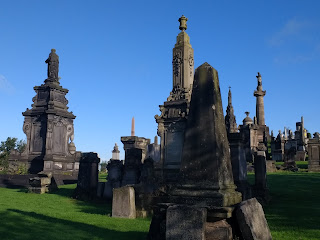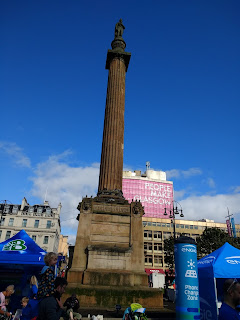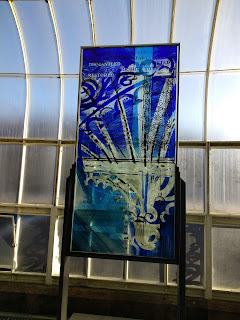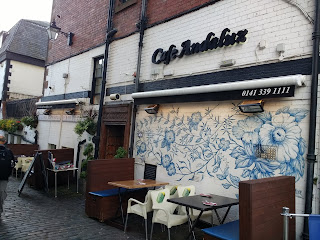It had been more than 40 years since I had visited Scotland with Sally, a friend from the private girls' school we attended in Ottawa, Canada. But we only toured part of the east coast of Scotland, including Edinburgh, as I recall Glasgow as being known then as a pretty gritty, industrial city. Since Steven hadn't been to what was once one of Europe's biggest cities and the second-largest city in Britain after London, we were both curious to explore the city located on the River Clyde.
I know you'd think from reading my posts over the years we must have a strange fascination with cemeteries but the major cemetery in Glasgow was supposed to be very interesting in our defense! The Glasgow Necropolis has been described as a 'unique representation of Victorian Glasgow, built when Glasgow was the second city of the British Empire. It reflected the feeling of confidence and wealth and security of that time.'
It was a memorial to the merchant patriarchs of the city and contained the remains of almost every eminent Glaswegian of its day. Monuments were designed by leading Glaswegian architects and executed by expert masons and sculptors who contributed ornate and sculptural detail of the finest quality. The Necropolis is considered one of the most significant cemeteries in Europe, in part because of its symbolic relationship to the nearby Glasgow Cathedral and to the medieval heart of the city.
If you click on the photo to make it bigger, you'll be able to see a little better the carved wooden bosses high on the ceiling. Bosses were decorative caps where the ceiling's ribs came together. The middle row showed the life of Jesus, while the sides indicated the miracles he performed and Christian symbols. The carvings were done around 1910 but some stone bosses were visible in the outer aisles.
In the center of the Lower Church that was built in the mid-1200s was a beautifully vaulted space and the tomb of St. Mungo. Glasgow's saint, St. Mungo, was a missionary in Strathclyde who may have built a church here before dying in 603. His sanctity was promoted by later bishops and he became a cult figure in the Scottish church. His tomb attracted many pilgrims who followed a stage-managed route to get here. They prayed for salvation, confessed crimes and sought cures. Their offerings helped boost church funds and the cathedral developed around his tomb.
The open timber roof was reconstructed in the early 20th century but some of the timber may date from the 14th century.
If you like killer plants, the Palace had lots for sale! These were plants that must attract, kill and digest their victims!
Next post: A walk through time in Glasgow's Tenement House!
Posted on April 19th, 2010, from a lovely springtime day at last in Denver. May you and your families be healthy and stay safe during this pandemic.
I know you'd think from reading my posts over the years we must have a strange fascination with cemeteries but the major cemetery in Glasgow was supposed to be very interesting in our defense! The Glasgow Necropolis has been described as a 'unique representation of Victorian Glasgow, built when Glasgow was the second city of the British Empire. It reflected the feeling of confidence and wealth and security of that time.'
According to travel writer Rick Steves, Glasgow's population during the Industrial Age in the early 1880s tripled to 200,000. The city needed a beautiful place to bury its 'beautiful' people as the existing cemeteries were jammed and unhygienic. Therefore, this grand necropolis was established.
The statuary was simpler than in a Catholic cemetery because Presbyterians were more into simplicity.
We looked but weren't successful finding Wee Willie Winkie's tombstone!
Atop the highest hill was a memorial to John Knox known as the Great Reformer even though he was actually buried in Edinburgh. Knox in more ways than one looked down on the cathedral that he wanted to strip of all art and even tear down.
A lane led from the cemetery over the 'bridge of sighs' to the Gothic, pre-Reformation Glasgow Cathedral.
It was once known as the 'Pink Church' for the shade of its stone until the Industrial Age soot and modern pollution blackened it! It was left black as cleaning would damage the integrity of the stone structure.
The cathedral, also known as St. Mungo's, was built as a Catholic cathedral but since the Scottish Reformation in 1560, it has been used for Protestant worship, nowadays by the Church of Scotland. The present cathedral was begun in the middle of the 13th century to provide a shrine to St. Mungo and was completed in 1500 after earlier stone cathedrals were destroyed. During the Reformation from 1517-1648, most of the elaborate decoration and altars in Scottish churches were destroyed.
Once just inside the entrance, we looked back at the elaborate stone tracery of the west window that was filled with stunning stained-glass depicting The Creation.
The Nave was part of the church where local people gathered to worship. I hadn't ever known the word 'nave' came from the Latin word navis meaning ship. That made sense when we looked up at the soaring ceiling as it resembled a ship's hull. At 32 meters high, it was the tallest nave in Scotland.
Originally there were many different altars in the nave, each dedicated to a particular saint.
John Knox and his Reformers ripped out the stained glass and ornate chapels that had been popular in the Catholic Age but fortunately left the church standing. The magnificent new windows mostly dated from the 19th century. These windows from 1951 celebrated the 14 trades in Glasgow, masons, carpenters, etc
This set of three windows told the story of St. Mungo retrieving a ring from the mouth of a fish.
Only in a Glasgow church would you see an angel playing the bagpipes!
The Choir for some reason was called the most sacred part of the church, likely, I'm guessing, because it contained the High Altar. It was once enclosed by screens which kept the clergy separate from pilgrims visiting the outer chapels.
A very unusual feature of the Glasgow Cathedral was that it was divided into Upper and Lower Churches. The Blacader Aisle was the part of the cathedral intended as the lower level of a chapel that was to be constructed above it. Archbishop Blacader in 1500 completed it with a vaulted ceiling.
In front of the cathedral was a big statue of David Livingstone, the Scottish missionary, explorer and cartographer who discovered a huge waterfall in Africa and named it in honor of his queen. Livingstone (1813-1873) was born just eight miles from this spot.
To get a sense of the downtown core, we decided to follow one of Rick Steves' walks. When we saw this mural along the River Clyde we didn't realize that Glasgow was known for edgy murals and the city had encouraged street artists to paint huge, fun murals.
To my fellow knitters, this is for you!
On Argyll Street, I popped into the extremely green sports store, the Celtic Shop, that was home to one of the hometown soccer teams called appropriately enough the Glasgow Celtics! Founded by an Irish Catholic priest to raise money for the poor Irish immigrants, the team is still favored by Catholics. The Celtic team name is pronounced 'sell-tic' as it is in Boston. However, when referring to music, language or culture, Steves said the word is pronounced 'kell-tic." I made sure to minimize any red, white or blue, the team colors of the Rangers, the team generally supported by Unionist and Protestant families!
Just around the corner from the shop in an alley were these amusing murals. There were no actual bricks on the wall in the first one. The artist Smug painted the second one - he included his name on the girl's necklace with the magnifying glass.
As the top shops in town were located on Buchanan Street and a few others, the district was known as the Style Mile. It was a fun place to wander with lots of street musicians.
So glad that we happened to look at the great stone sculptures along Buchanan Street! This gave us our first appreciation of the wealth of imaginative facades and expressive sculpture throughout the city.
The Argyll Arcade was the oldest arcade in town and dated from 1827. With all its fabulous gold and diamond stores, it reminded us right away of the gold souks we'd seen all over the Middle East! We only looked at the shop windows and gasped at the prices.
No, these weren't dominoes but mammoth diamond rings!
A few doors down was Princes Square, a classic old building with a modernized Art Nouveau atrium.
Another Art Nouveau delight was the Willow Tea Room designed by Scotland's most famous architect, Charles Rennie Macintosh.
I could see how architecture buffs would have a field day in Glasgow. I didn't take note of what this building was but I certainly found it very appealing. In one of its ground floor windows was a display of ancient Singer sewing machines. I have one just like it that my mother gave me eons ago!
We passed through an arched gate to reach Royal Exchange Square which marked the entrance to another shopping zone called Merchant City.
The Glasgow Gallery of Modern Art was now ensconced in what was once the private mansion of one of the tobacco lords, "the super-rich businessmen who reigned here through the 1700s, stomping through the city with gold-tipped canes," according to Steves! During the city's heyday, these businessmen helped Glasgow become Europe's sixth biggest city and the second in the British Empire.
We walked around the rebuilding to reach the main entrance and the equestrian statue of the Duke of Wellington.
I read that often the statue is adorned with a conehead but it wasn't unfortunately then!
As modern art is not our 'thing' and we wanted to see still lots more that day, we just looked inside at the impressive dome before leaving.
A few steps away was St. George's Square that was decorated with a Who's Who of famous Glaswegians. James Watt invented the steam engine that helped propel England into the Industrial Age
Not to be outdone were statues of Scotland's most famous literary figures: Robert Burns astride a horse and Sir Walter Scott on the tallest pillar in the center.
Another notable Scot!
The big Neoclassical building on the square that almost looked like a church with its tall central spire was the Glasgow City Chambers.
St. George's Church must have been closed as we rarely miss the opportunity to enter a church or religious building of any denomination!
The Stock Exchange with its Neo-Gothic design was built in 1875. The idealized heads on its facade represented the industries that made Glasgow prosperous during its heyday: mining, building and engineering.
Kudos to Glasgow's leaders who were the first to honor Nelson Mandela while he was still in prison attempting to abolish apartheid by naming this square the Nelson Mandela Plaza. Done in the 1980s when the South African consulate was located there, it meant that anyone addressing a letter to the consulate had to include the name of the man who embodied the anti-apartheid spirit!
Around the corner from the church was the Athenaeum, founded in 1847 as a school and city library. Its inaugural address was made by Charles Dickens. Glasgow, like Edinburgh, was at the center of the 18th century Scottish Enlightenment which was a combination of education and intellectualism. What that meant, in reality, was that all members of society were expected to be well educated.
Above the door was the embodiment of that ideal, a statue of a reader sharing books with a young child.
As we walked to the top of Buchanan Street and reached the Glasgow Royal Concert Hall, we were struck by the large numbers of smokers and homeless people in the city as we hadn't come across either to that extent in our previous five weeks in Ireland and the United Kingdom.
The statue in front was of Donald Dewar, Scotland's first-ever First Minister after the Scottish Parliament met in 1999 for the first time since 1707. In that long interim, Scottish interests had been represented in London as part of the British Parliament.
We noticed that a booth promoting complete independence from Britain attracted lots of interest.
During the industrial boom of the late 19th century, when more people moved to the suburbs, office workers were unable to return home for lunch. That, combined with the temperance movement which discouraged the consumption of alcohol, promoted the growth of tearooms as an appealing alternative to eating in pubs. Macintosh also designed this original Willow Tea Rooms on Sauchiehall Street in 1903 even down to the furniture, lighting, and cutlery! His theme for the cafe came from the name of the street as saugh was Scots for willow.
Both the exterior and interior were an Art Nouveau delight. I enjoyed learning that the tearooms also gave a place for women to gather while unescorted in an age when traveling alone was frowned upon. It was no mistake the rooms were bathed in white, as that was the suffragettes' signature color.
We then detoured to the Tenement House, a perfectly preserved period home occupied by Miss Agnes Toward to get a sense of how many Glaswegians lived in the first half of the 20th century. Preserved by the National Trust of Scotland, it was like a time warp! Since we spent so much time 'walking through history,' my description of the house was pretty extensive and is the subject of a separate post.
From the Tenement House it was a longish but very enjoyable walk past some attractive Georgian buildings and others with intriguing facades toward the center where we'd left our rental car.
We began our tour of the West End at the Glasgow Botanic Gardens that Glaswegians were happy to claim that, despite the city's industrial reputation, they had more green space per capita than any other city in Europe! The city's seal on the gardens' entrance gate honored the near legendary city founder, St. Mungo, whom we'd first head about at the city's cathedral that morning.
As the sun was shining, the park was packed on such a beautiful afternoon.
In addition to the landscaped gardens, there were also two greenhouses, necessary, I was guessing, in the city's often inclement weather! That day was the first sunny day we'd had in far too many so we just plopped down on the benches basking in the sun's rays before venturing indoors.
I read that 1000 begonias have been found growing wild in the tropics and sub-tropics. If that weren't already enough, the creation of many hybrids has greatly increased the variety.
As we wandered through more of the extensive gardens, we saw cereal gardens, medicinal gardens, others that contained dye plants and also scented plants, all of which were very new to us.
Kibble Palace, the large white greenhouse, opened in 1873, was certainly very elegant with classical statues scattered among the palm fronds.
The marble statue of Eve was carved about 1875 by a Roman artist who depicted the first woman of the human race according to the Bible covering her nakedness in shame, after eating the forbidden fruit from the tree of knowledge.
In early January 1968, a hurricane hit Glasgow during the night which caused extensive damage throughout the city. Although 2,000 trees were destroyed in city parks, only 24 were lost in the Botanic Gardens. The Palace was unscathed but the greenhouses lost more than 400 panes of glass.
If you like killer plants, the Palace had lots for sale! These were plants that must attract, kill and digest their victims!
Just outside the gardens was this police call box that used to serve as a neighborhood mini office for the bobbies, aka police officers, who could store paperwork and equipment, use the phone and also catch up with each other. Some old call boxes have been converted into coffee shops, ice cream stands and, appropriately, time machines!
Just down the street from the gardens, a former movie theater had been converted into an upscale bar cum restaurant.
Around the corner was a row of red sandstone tenements. Judging from the bulging bay windows and prime location, these were clearly very desirable. Some were likely occupied by students as the University of Glasgow was right around the corner.
Across the street was a baths club, the equivalent of an exclusive health club for us in North America, with its own swimming pool. As I wrote earlier concerning the Tenement House, historically, most Glaswegians didn't have bathing facilities in their own homes, so they came to central locations like this one to bathe every few days or weeks! Nowadays, the situation has reversed and it's the wealthy, not the poor, who can afford places like this.
What a lark then strolling along the very appealing Ashton Lane that was strung with fairy lights and had a very unusual assortment of stores and restaurants!
From the beer garden to a tea shop a few steps away, the city catered to all tastes! I hope you can tell Steven and I had a delightful day in Glasgow from beginning to end. It sure blew away my old preconceptions of what I thought would be a dreary industrial city. I encourage anyone lucky enough to visit Scotland when we can all travel internationally again to make sure to put Glasgow on your 'must-see' sights as you won't be disappointed!
Next post: A walk through time in Glasgow's Tenement House!
Posted on April 19th, 2010, from a lovely springtime day at last in Denver. May you and your families be healthy and stay safe during this pandemic.





























































































































Did you park your Broom there??? Lil Red
ReplyDeleteWhile I was lucky enough to visit Scotland many times when Erica was studying at St Andrews, I did not spent anytime in Glasgow... obviously a big mistake based on your post. I loved your photos and descriptors of the many historic buildings, statues and colourful wall murals.. but my favourites are the photos , inside and out , of the Glasgow Botanical Gardens ! Thanks for the tour !! Stay well, hopeful and connected during these crazy times. xoxo
ReplyDeleteLina,
DeleteI don't know how I never knew before this trip that Glasgow was such a major city in the British Empire and at the forefront of the education of the masses movement, plus their attention to the Art Nouveau movement and quite stunning architecture.
Wonderful to know Steven and I are still learning so much about cities that we, or I at least, mistakenly and ignorantly thought we knew already. Always glad to share our discoveries with you and others via the blog, my dear.
Love and hugs from afar which is even truer in these troubled times,
Annie
Lil Red,
ReplyDeleteI couldn't help but laugh when I read your comment - too cute! Hope you also enjoyed the photos of the gardens - I love seeing gardens the world over and discover how each is so different. Imagine having a 'cereal garden,' etc - brilliant thiking!